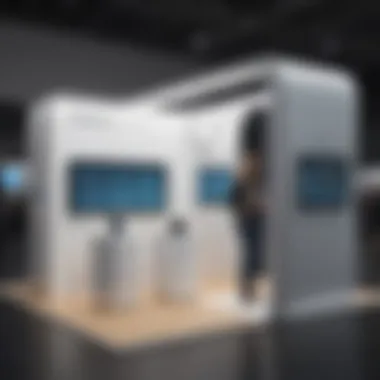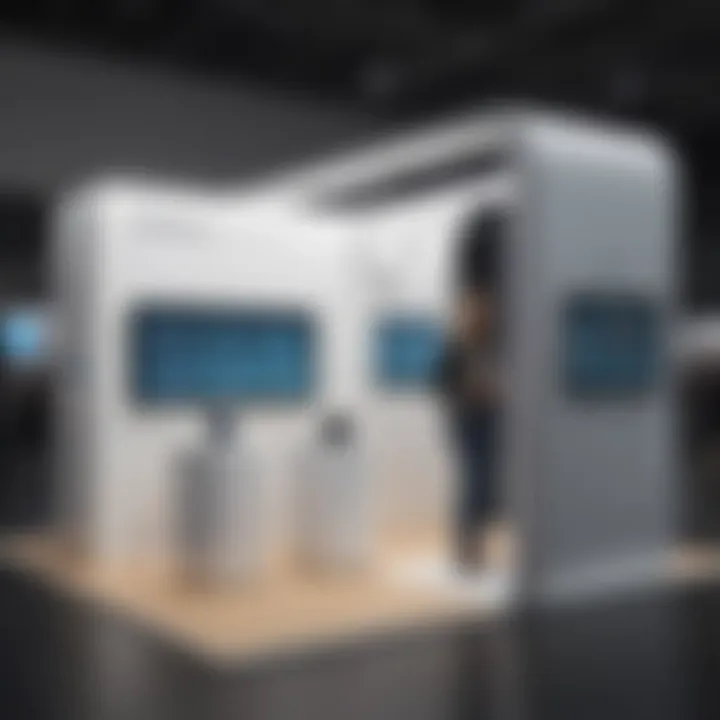Exploring Airmeet Booths for Enhanced Engagement


Intro
In the realm of virtual and hybrid events, the integration of innovative tools has become vital for enhancing engagement and networking. One such tool is the Airmeet booth. As businesses adapt to the new normal, understanding the operational dynamics, features, and applications of Airmeet booths becomes crucial.
Airmeet booths facilitate seamless interaction among participants, bridging geographical gaps and fostering relationships. This article seeks to explore the significance and capabilities of Airmeet booths, providing insights for small to medium-sized businesses, entrepreneurs, and IT professionals.
Software Overview
Definition and Purpose of the Software
Airmeet booths are digital spaces designed for exhibitors, sponsors, and attendees in virtual events. They serve as platforms where various stakeholders can engage in discussions, showcase products, and share content in real-time. The primary purpose is to create an environment that mimics the interactions of physical booths but in an online setting, thereby enhancing the participant experience.
These booths are critical for businesses aiming to increase their visibility and create meaningful connections. They cater to various event types, including conferences, trade shows, and networking events. The flexibility and adaptability of these booths enable organizations to tailor their virtual presence according to specific goals and audience needs.
Key Features and Functionalities
Airmeet booths boast several features that set them apart:
- Live Video Streaming: Participants can engage in live discussions, allowing for real-time interaction.
- Chat Functionality: Attendees can send text messages and questions to booth representatives, promoting two-way communication.
- Content Sharing: Exhibitors can upload brochures, videos, and presentations directly to the booth for easy access by visitors.
- Analytics and Reporting: Organizations can track engagement metrics and analyze participant behavior to refine their strategies.
- Networking Opportunities: Attendees can network with each other via one-on-one video chats or group discussions, facilitating professional connections.
"Engagement and networking are essential for successful virtual events, and Airmeet booths provide the tools necessary for achieving this."
Comparison with Alternatives
Overview of Competitors in the Market
While Airmeet offers unique advantages, it is essential to consider how it measures up against other platforms. Competitors such as Hopin, Virtualbooth, and EventMobi also provide similar functionalities but differ in execution and features.
Key Differentiators
What distinguishes Airmeet from its competitors? Here are some key differentiators:
- User-Friendly Interface: Airmeet is designed with simplicity in mind, allowing users to navigate easily.
- Immersive Experiences: It emphasizes creating an engaging atmosphere through various multimedia elements.
- Affordable Pricing: Compared to some alternatives, Airmeet offers competitive pricing structures, making it accessible for small to medium-sized businesses.
In summary, understanding Airmeet booths can transform how businesses implement virtual events. The blend of features and functionalities ensures that organizations can create compelling experiences. By exploring this tool in depth, decision-makers can make informed choices about integrating technology into their event strategies.
Preface to Airmeet Booths
In the contemporary landscape of virtual and hybrid events, Airmeet booths represent a significant innovation. They serve as virtual spaces where businesses can engage with their audience, showcase products, and network with attendees. The understanding of Airmeet booths is paramount for small to medium-sized businesses, entrepreneurs, and IT professionals seeking to enhance interaction and maximize exposure during events.
Airmeet booths offer unique functionalities that traditional booths do not provide. They empower businesses to create a tailored experience for attendees, which is crucial in a saturated digital environment. With features such as customizable designs, real-time engagement tools, and the ability to collect data, Airmeet booths cater specifically to the evolving needs of event stakeholders.
Moreover, the importance of these booths extends beyond mere aesthetics and functionality. They play a role in enhancing brand visibility and fostering relationships that can lead to future business opportunities. For organizations looking to leverage digital events effectively, understanding the nuances of Airmeet booths is essential.
As the virtual event space continues to grow, proactively adapting to new technologies and platforms, such as Airmeet, becomes increasingly important. By examining Airmeet booths, this article will provide insights into their operation and strategic value for businesses aiming to optimize their participation in virtual events.
"Airmeet booths are not just virtual spaces; they are a gateway to unprecedented engagement and interaction, reshaping how brands connect with their audience."
In summary, this section underscores the vital role of Airmeet booths in enhancing the virtual event experience. Their impact on visibility, engagement, and data analytics makes them an indispensable tool for modern businesses striving to stay competitive in a digital-first world.
Defining Virtual Booths
Defining virtual booths is essential for understanding their role in the landscape of digital events. Virtual booths serve several purposes, allowing companies to showcase their products, engage with potential customers, and network effectively. They are not just static displays; they encapsulate a dynamic platform for interaction.
The importance of virtual booths lies in their ability to simulate the experience of physical trade shows in an online environment. This transformation has significant implications, especially in a world where in-person gatherings are not always feasible. With companies increasingly opting for remote events, understanding the essence of virtual booths can drive better business outcomes.
Overview of Virtual Booth Technology
Virtual booth technology is the backbone of online exhibitions. It employs various software and hardware to create immersive experiences that mimic real-world booths. This technology typically includes:
- 3D simulated environments, allowing users to navigate through a virtual space.
- Live streaming capabilities, enabling real-time interaction.
- Integration with CRM systems, helping to collect data on booth visitors.
By utilizing this technology, businesses can enhance their outreach, while participants gain an engaging experience that fosters connections.
Evolution of Booths in Digital Events
The journey of booths in digital events has been marked by innovation and adaptation. Over the years, they have evolved from simple banner ads to full-fledged interactive environments. Initially, digital booths were basic web pages or links with limited interactivity. As technology advanced, features such as video conferencing, chat functionalities, and analytics tracking were integrated.
- Early Stages: Basic representations of physical booths. Limited user interaction.
- Growth in Features: Introduction of multimedia elements, such as videos and documents.
- Current State: Highly interactive spaces with networking tools, gamification elements, and robust data analytics.
This evolution underlines the importance of staying abreast of technological developments to create compelling virtual experiences that meet audience expectations.


Key Features of Airmeet Booths
The section focuses on vital elements that define Airmeet booths within the framework of virtual and hybrid events. Understanding these key features enhances the ability of businesses to engage their audience effectively. The functionalities presented in Airmeet booths can significantly impact how brands communicate their value and offerings to attendees. This section articulates the nuances of customizable booth designs, engagement tools, and networking capabilities which are essential for maximizing interaction and visibility.
Customizable Booth Designs
Customizable booth designs are essential for tailoring the user experience. By enabling businesses to personalize their booths, Airmeet allows firms to reflect their brand identity effectively. The design process involves choices in color schemes, layouts, and overall aesthetics. Participants can create an environment that resonates with their target audience. Customization fosters an immediate connection between the brand and its visitors.
Moreover, a well-designed booth can draw in attendees and keep them engaged longer. Customization options encourage creativity and innovation. Brands can incorporate logos, multimedia, and interactive elements that attract visitors. Unique designs also allow businesses to differentiate themselves from competitors, thereby increasing brand recognition.
Engagement Tools and Interactive Elements
Engagement tools are the backbone of any successful virtual booth experience. Airmeet offers a range of interactive elements designed to capture attention and promote participation. Tools such as live chat, video conferencing, and real-time Q&A sessions create an active dialogue between the host and participants. These interactions are crucial for maintaining interest in a virtual environment.
Employing engagement tools can significantly enhance the value of the attendee experience. Visitors are more likely to stay engaged when there are opportunities for interaction. Additionally, elements such as gamification and interactive product demos can make the experience more enjoyable. It is essential for brands to utilize these tools to create memorable interactions that leave a lasting impression.
Networking Capabilities
Networking is one of the primary advantages of Airmeet booths. The platform provides features that facilitate connections between attendees, exhibitors, and speakers. These capabilities allow businesses to foster meaningful relationships and expand their potential customer base.
Elements such as one-on-one video chats and group discussions provide unique networking opportunities. Attendees can meet with industry peers or potential clients directly, enriching the overall event experience. For many participants, these connections can lead to partnerships or collaborations that continue beyond the event.
Benefits of Using Airmeet Booths
Airmeet booths serve multiple purposes in the virtual event sphere. Understanding the benefits of using these booths is essential for organizations looking to maximize their impact. The advantages range from enhanced visibility to effective data collection. Here, each aspect is explored in detail to uncover its significance for businesses.
Enhanced Brand Visibility
One of the primary benefits of Airmeet booths is the potential for enhanced brand visibility. In the crowded online marketplace, making a memorable impression is vital. Airmeet booths allow businesses to showcase their brands in a visually appealing manner. By customizing booth designs, organizations can highlight their branding elements effectively. This customization helps draw attention.
Additionally, interactive elements such as videos and demos can further elevate brand presence. Attendees are more likely to engage with content that is visually stimulating. When organizations incorporate their unique style and branding into their virtual booths, they create a lasting impression that can lead to increased brand recognition.
Cost Efficiency Compared to Physical Events
Cost efficiency is another significant advantage of using Airmeet booths. Traditional physical events often come with high overhead costs including venue rentals, travel expenses, and material production. Shifting to virtual events offers a more economical solution. Organizations can allocate their budgets more effectively by reducing these expensive factors.
Moreover, Airmeet booths eliminate the logistical challenges associated with physical venues. There are no issues with setup or breakdown, and businesses save time and resources. This efficiency enables organizations, especially small to medium-sized businesses, to take part in more events without increasing their budget.
"The transition to virtual platforms removes numerous barriers related to costs and logistics, making participation more accessible for all companies."
Data Collection and Analytics
Airmeet booths also provide robust data collection and analytics capabilities. Gathering data from virtual events is critical for assessing performance and enhancing future efforts. Airmeet enables businesses to track visitor engagement. This includes metrics like how long attendees interact with booth content or which sessions are most attended.
With such analytics, organizations can make informed decisions. For example, they can identify which products or services generate the most interest. This information can be invaluable for crafting future marketing strategies. The ability to analyze participant behavior allows businesses to tailor their content more effectively, ensuring it meets audience expectations and needs.
Setting Up Airmeet Booths
Setting up Airmeet booths is a crucial component in the effort to maximize engagement during virtual events. This process directly influences how attendees interact with the content and with each other, ultimately affecting the overall success of the event. A well-configured booth not only attracts visitors but also encourages meaningful interactions, making it a valuable asset for businesses aiming for effective outreach.
Step-by-Step Setup Process
Creating an Airmeet booth involves several key steps that ensure a smooth setup and optimal functionality. Here are the primary actions to take during the setup process:
- Creating an Account: First, sign up for an Airmeet account. Choose a suitable plan based on your needs, as Airmeet offers various packages targeted at different audience sizes and features.
- Selecting an Event Type: After account creation, select the type of event you are hosting. This could be a conference, a workshop, or a product launch. Your event type will guide the booth's structure and features.
- Designing the Booth Layout: Use the intuitive interface to design the booth layout. You can select from various templates or create a custom design that fits your brand identity. Ensure that the design is user-friendly and visually appealing.
- Adding Content: Populate the booth with relevant content such as images, videos, brochures, and presentations. Engaging content will keep visitors interested and enhance their overall experience.
- Configuring Interactive Elements: Integrate interactive features like live chat, Q&A sessions, and polls. These elements can make the booth more engaging and allow for real-time interaction with attendees.
- Testing the Booth: Before going live, conduct thorough testing. Ensure that all media loads correctly, links work, and interactive features function as intended. Testing helps identify any glitches that need to be addressed.
- Going Live: Once everything is in place and tested, you can go live. Monitor interactions and be ready to engage with attendees as they enter the booth.
By following these steps, hosting organizations can create a robust Airmeet booth that maximizes engagement and provides valuable resources for attendees.
Best Practices for Configuration
To enhance the effectiveness of Airmeet booths, there are several best practices that should be followed during configuration:
- Maintain Brand Consistency: Ensure that the booth reflects your brand’s identity. Use brand colors, logos, and messaging that match your overall marketing strategy.
- Focus on User Experience: Design the booth with the end-user in mind. Make information easy to access and ensure that navigation is intuitive. Visitors should find what they need without frustration.
- Engage Early: Consider implementing automated greeting messages or welcome videos to engage attendees as soon as they enter the booth. Initial engagement can significantly impact the quality of interaction.
- Offer Valuable Resources: Include downloadable content that attendees can take with them. This can include whitepapers, case studies, or detailed product information that adds value beyond the event.
- Gather Feedback: Post-event surveys can provide insights into how well the booth functioned and what improvements can be made for future events. Consider asking participants about their experiences in the booth.
Implementing these best practices can significantly enhance the effectiveness of Airmeet booths. This leads to improved attendee satisfaction and better overall event outcomes.
"An effectively set up booth is often the difference between a passive viewer and an engaged participant."
By taking the time to properly set up and configure Airmeet booths, organizations can effectively utilize this technology to foster engagement and networking opportunities.
Engagement Strategies Within Airmeet Booths
The effectiveness of virtual events significantly depends on how well attendees are engaged. Airmeet booths serve as virtual exhibition spaces, making it crucial to implement effective engagement strategies. These strategies not only capture the audience's attention but also foster meaningful interactions between exhibitors and participants.


Effective engagement leads to deeper networking opportunities, information sharing, and ultimately better brand recall. This is especially important for small and medium-sized businesses that are often competing for attention against larger corporations. By focusing on the right engagement strategies, these businesses can enhance their visibility and build meaningful relationships with potential clients.
Interactive Sessions and Webinars
Interactive sessions and webinars within Airmeet booths are central to enhancing user involvement. They provide an opportunity for real-time communication and knowledge sharing. Unlike traditional webinars, which can often feel passive for attendees, interactive sessions invite participants to engage directly.
These sessions can take various forms:
- Live Presentations: These can cover topics relevant to the audience, where exhibitors showcase their products or services.
- Workshops: Providing hands-on experience allows attendees to learn new skills. This direct involvement can lead to higher retention rates of information.
- Networking Events: These casual meet-and-greet sessions can break down barriers and encourage conversation.
The ability to ask questions, provide feedback, and interact with the facilitator can make attendees feel more connected. This connection strengthens brand loyalty and increases the likelihood of future engagement.
Q&A and Live Polling Options
Incorporating Q&A and live polling options is another essential strategy in Airmeet booths. These elements can transform a passive viewing experience into an engaging interaction.
Q&A sessions allow attendees to voice their questions and concerns directly to speakers or representatives. This exchange can address specific issues, making the attendees feel valued and heard. It also provides valuable insights to the exhibitors about audience expectations and interests.
Live polling serves to gauge audience opinions in real-time. Polls can be conducted on various topics, ranging from product preferences to general industry trends. This not only involves the audience but also gathers data that can inform interactive discussion. Engaging attendees through real-time feedback creates a sense of community and shared experience, furthering their connection to the event and the brand.
"Engagement strategies are not just enhancements; they are essential for gaining the interest and trust of your audience in virtual settings."
Effective engagement strategies within Airmeet booths tailors the experience to the unique preferences of the audience. By focusing on interactive sessions and fostering direct communication through Q&A and live polling, businesses can enhance their event's overall quality and effectiveness.
Integration with Other Tools
The integration of Airmeet booths with other tools is crucial in enhancing the overall functionality and user experience during virtual and hybrid events. By connecting these booths with various systems, businesses can streamline their operations, gather valuable data, and foster more effective communication. This section examines the intersections between Airmeet booths and essential software solutions, specifically focusing on CRM and marketing automation tools, as well as social media and communication platforms. Each integration brings specific benefits and considerations that can drive engagement and maximize return on investment.
CRM and Marketing Automation Tools
Integrating Airmeet booths with CRM (Customer Relationship Management) and marketing automation tools provides a seamless flow of information between event participants and business environments. Software like Salesforce or HubSpot can automate collection and management of leads generated through the booths. This integration enables businesses to track interactions, segment audiences, and tailor follow-up strategies based on participant behavior.
- Enhanced Data Collection: Automated data input creates less room for errors and provides a more precise analysis of participant engagement and interests.
- Targeted Marketing Campaigns: Companies can utilize information gathered to create personalized marketing strategies. If a participant shows interest in a particular service, targeted communications can be delivered to them.
- Streamlined Follow-ups: The ease of integrating leads into a CRM means that sales teams can follow up promptly with potential customers, increasing the chances of conversion.
Implementing these integrations requires some technical considerations. Organizations must ensure that their tool sets are compatible and that they follow best practices for data privacy and security. Proper training for personnel using these integrated systems is also essential for maximizing their benefits.
Social Media and Communication Platforms
Social media platforms like Facebook, Twitter, and LinkedIn serve as vital channels for promoting events and engaging with audiences. Airmeet booths can connect to these platforms to boost visibility and enhance interaction during events. The integration allows organizers to use social media for various functions such as marketing, real-time updates, and participant engagement.
- Real-Time Promotion: With direct connections, announcements about live sessions or special offers can be pushed to social media channels instantly, keeping participants informed.
- Engaged Audience Participation: Integrating platforms like Twitter can facilitate live conversations and feedback during events, increasing audience participation and satisfaction.
- Post-Event Analysis: After the event, social media metrics combined with data from Airmeet booths can provide insights into audience engagement. Organizations can analyze which social media posts garnered the most interaction and tailor future campaigns accordingly.
Integrating Airmeet booths with social media and communication tools adds layers of interactivity and increases reach. However, businesses should carefully evaluate which platforms are best suited for their specific audience to avoid diluted messaging and ineffective strategies.
"The ability to seamlessly integrate Airmeet booths with other essential tools can exponentially enhance the efficacy of virtual events."
Case Studies of Successful Airmeet Booth Implementations
The exploration of Airmeet booths is incomplete without examining case studies that showcase their real-world applications. Case studies illuminate how different industries leverage Airmeet booths to enhance engagement and maximize networking. By analyzing these specific implementations, businesses can gain insights into best practices and potential outcomes of using this platform.
One of the primary benefits of using case studies is that they provide concrete examples of success. They highlight specific challenges that businesses faced before implementing Airmeet booths and how these challenges were overcome. Furthermore, such insights allow decision-makers to evaluate the potential impact on their own operations based on real experiences.
Industry-Specific Success Stories
Airmeet has been employed across various sectors, such as technology, education, and healthcare, each reaping unique benefits.
- Technology Sector: A leading SaaS company implemented an Airmeet booth during its product launch event. The booth featured live demos, allowing attendees to interact directly with the product team. The result was a 40% increase in lead generation compared to their previous physical event.
- Education Sector: A university utilized Airmeet booths for its virtual open days. Prospective students engaged with faculty and current students in real-time, leading to a 30% increase in applications. The interactive elements, including Q&As, were instrumental in easing concerns about online learning.
- Healthcare Sector: A health organization hosted a conference on public health issues using Airmeet booths. Experts shared valuable insights while attendees networked with professionals in their field. Feedback indicated a high level of satisfaction concerning networking opportunities, which was crucial for future collaborations.
These success stories highlight how industry-specific needs can be met effectively through Airmeet booths, reinforcing their versatility and adaptability.
Analyzing Engagement Metrics
In any event or exhibition, understanding engagement metrics proves essential. Analyzing these metrics provides valuable information regarding the effectiveness of Airmeet booths.
- Participant Interactions: Metrics such as the number of visitors to booths and the duration of stay can reveal how engaging the content is. For example, a booth that keeps participants for longer durations could signify valuable content or interactive experiences.
- Lead Generation Quality: Evaluating the quality and quantity of leads generated during an event can guide future marketing efforts. Metrics such as contact form submissions and requests for follow-up meetings are critical.
- Feedback and Satisfaction Scores: Collecting feedback through surveys post-event allows organizations to gauge participant satisfaction. High satisfaction rates can indicate successful engagements and content delivery.
"Evaluating engagement metrics is not just about numbers; it's about understanding your audience's needs and enhancing their experience in future events."
By focusing on these precise data points, businesses can refine their strategies for future events, ensuring their Airmeet booths achieve intended outcomes.
Challenges and Limitations


In this era of virtual events, it is crucial to recognize challenges and limitations faced by platforms like Airmeet. These aspects can often deter users and impact overall experience. Understanding them not only helps organizations prepare, but also allows for informed decision-making when adopting new technologies. In the context of Airmeet booths, being aware of these challenges provides noteworthy insights into their operational effectiveness.
Technical Difficulties
Technical difficulties can arise during events, which can hinder participation and engagement. Issues may include software glitches, poor internet connectivity, or compatibility problems with various devices. On occasions, platforms may experience outages or slow processing times, leading to frustration among attendees. These hurdles can negatively impact the flow of presentations or discussions.
To mitigate such risks, companies should consider the following guidelines:
- Conduct Pre-Event Testing: A thorough testing process ensures that every aspect functions correctly before the event begins.
- Provide Technical Support: Having a support team available during events can help address any issues promptly.
- User Education: Offering tutorials or guides can reduce confusion with the software and allow users to feel more comfortable.
User Experience Concerns
User experience is another vital component influencing the success of Airmeet booths. If users find the interface confusing or overwhelming, they may disengage quickly. Complicated navigation can lead to lower interaction rates and dissatisfaction.
Several factors contribute to user experience:
- Design and Usability: An intuitive interface promotes better engagement. Poor design choices can create barriers for users, impacting their ability to make the most of the platform.
- Accessibility Features: It is essential to incorporate elements that ensure inclusivity, such as functions for those with disabilities. This can significantly expand the user base.
- Feedback Mechanisms: Encouraging users to share their thoughts about the experience can provide invaluable insights for improvement.
"Understanding and addressing challenges can lead to a more effective implementation of Airmeet booths, enhancing overall engagement and satisfaction."
By recognizing and addressing these technical difficulties and user experience concerns, businesses can create a more robust and engaging environment. Such measures not only improve satisfaction but also optimize the overall functionality of Airmeet booths.
Future Developments in Airmeet Technology
As virtual events continue to gain momentum, it is essential to consider the future developments in Airmeet technology. This section discusses significant advancements and their implications for businesses and organizers. Embracing these developments can enhance user experience, improve engagement, and foster better networking opportunities during events.
Innovations on the Horizon
One of the key aspects of Airmeet booths is the continuous innovation that shapes their functionality. Several expected innovations will likely transform how businesses utilize these virtual spaces:
- Augmented Reality (AR) Features: The integration of AR in Airmeet booths aims to create immersive experiences. Users may interact with 3D product models or promotional content, grabbing attention in a saturated digital environment.
- Advanced Analytics Tools: Enhanced data analytics will allow organizers to gain deeper insights into attendee behavior. Understanding patterns such as how long users spend in booths or which resources are downloaded can inform future event strategies.
- Artificial Intelligence (AI) Personalization: AI is set to play a significant role in customizing attendee experiences. By analyzing user data, Airmeet can suggest relevant sessions or booths, streamlining the user journey and increasing engagement levels.
Impact of Emerging Technologies
The impact of emerging technologies cannot be overlooked. As Airmeet evolves, these technologies will play a central role in redefining how virtual events are organized and experienced. Consider the following:
- Blockchain for Security: By incorporating blockchain technology, Airmeet can enhance security measures, ensuring attendee data remains private and secure. This approach builds trust among users and encourages participation.
- Integration with IoT Devices: Smart event technologies such as IoT devices can enhance interaction. Attendees may use mobile applications connected to their wearables to tap into exclusive content or networking opportunities seamlessly.
- Seamless Cross-Platform Integration: As businesses utilize various tools for events, the ability for Airmeet to integrate with other platforms becomes crucial. This streamlining helps in managing marketing, communication, and analytical needs effectively.
"The future of virtual events lies in leveraging technology that not only enhances user experience but also offers meaningful engagement opportunities."
The innovations and emerging technologies poised to affect Airmeet booths significantly highlight the importance of staying ahead of industry trends. Understanding and adapting to these developments can lead to a competitive advantage in the ever-evolving landscape of virtual events.
Ending
The significance of the conclusion in this article revolves around summarizing the critical insights gained throughout the comprehensive exploration of Airmeet booths. This final section serves as a synthesis point, bringing together the essential aspects of the prior discussions, which include the features, applications, and benefits of utilizing Airmeet technology in virtual events.
For small to medium-sized businesses, entrepreneurs, and IT professionals, the knowledge imparted in this article is invaluable. It outlines how Airmeet booths can elevate engagement levels during virtual gatherings and hybrid formats. The emphasis on interactive elements, customizable designs, and networking capabilities showcases the alignment of Airmeet booths with modern communication strategies.
Business leaders must recognize that adopting such digital solutions enhances brand visibility as well as improves cost efficiency compared to traditional event formats. The article also underscores data collection and analytics, which allow for informed decisions that can drive future marketing and operational strategies.
Moreover, addressing the challenges and limitations presents a balanced view. Understanding potential technical difficulties and user experience concerns equips readers with realistic expectations and readiness for effective implementation.
In revisiting the significance of future developments and innovations in Airmeet technology, the article prompts readers to stay informed about the advancements that will shape virtual events moving forward. These insights can prove advantageous for organizations looking to maintain a competitive edge in increasingly digital marketplaces.
Ultimately, this article aims to empower decision-makers with the tools and knowledge necessary to leverage Airmeet booths effectively, maximizing the potential of virtual interactions.
"Understanding how to navigate the landscape of virtual events is essential for future success. Airmeet booths are not just a trend; they represent a shift in how businesses engage with their audience."
By integrating the conclusions drawn from this in-depth analysis, businesses can take proactive steps in enhancing their virtual event strategies and fostering meaningful connections in a digital era.
Appendices and Additional Resources
The inclusion of appendices and additional resources is a significant aspect of this article, reinforcing the understanding of Airmeet booths. Such components serve to enrich the reader's knowledge base and provide supplementary information that may not fit neatly into the main narrative. They become a crucial reference point for small to medium-sized businesses, entrepreneurs, and IT professionals who aim to enhance their virtual event experiences.
Links to Further Reading
When delving into the world of Airmeet booths, it is essential to have access to additional literature that covers various dimensions of virtual events, technology integration, and user engagement strategies. By exploring relevant articles, studies, and online guides, one can gain fresh insights and perspectives. Here are a few noteworthy resources:
- Virtual Events: How to Make Them Successful
- Understanding Hybrid Events in Today's Context
- Effective Networking in Digital Environments
- Using Airmeet for Successful Events
These links lead to articles that can greatly assist in understanding how to effectively implement and utilize Airmeet booths as part of broader virtual event strategies.
Glossary of Terms
A concise glossary can serve as a handy reference for readers, especially those who may be unfamiliar with certain terminologies specific to Airmeet booths and virtual events generally. The following terms are essential:
- Airmeet Booth: A virtual space within the Airmeet platform designed to facilitate networking, interaction, and information sharing during online events.
- Virtual Event: An event that is conducted through digital means, allowing participants to engage in real-time from any location.
- Networking Tools: Features that enable attendees to connect, communicate, and collaborate with each other during an event.
- Interactive Elements: Components of virtual booths that enhance engagement, such as quizzes, polls, or video feeds.
Creating a glossary helps streamline communication and ensures the effectiveness of the article in conveying complex information. Each entry not only clarifies concepts but also reinforces the overall topic at hand.















